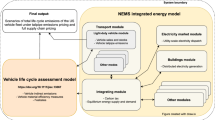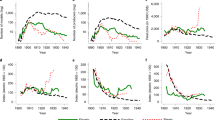Abstract
In the past three decades, government, industry and other stakeholders have repeatedly been swept up with the ‘fuel du jour’, claiming that a particular alternative fuel vehicle (AFV) technology can succeed in replacing conventional gasoline-powered vehicles. However, AFV technologies have experienced relatively little success, with fossil fuels still accounting for about 95% of global transport energy use. Here, using the US as a case study, we conduct a media analysis to show how society’s attention has skipped among AFV types between 1980 and 2013, including methanol, natural gas, plug-in electric, hybrid electric, hydrogen and biofuels. Although our results provide no indication as to whether hype ultimately has a net positive or negative impact on AFV innovation, we offer several recommendations that governments can follow to move past hype to support significant AFV adoption and displace fossil fuel use in the transportation sector.
This is a preview of subscription content, access via your institution
Access options
Subscribe to this journal
Receive 12 digital issues and online access to articles
$119.00 per year
only $9.92 per issue
Buy this article
- Purchase on Springer Link
- Instant access to full article PDF
Prices may be subject to local taxes which are calculated during checkout





Similar content being viewed by others
References
Sims, R. et al. in Climate Change 2014: Mitigation of Climate Change (eds Edenhofer, O. et al.) 599–670 (Cambridge Univ. Press, 2014).
Energy and Climate Change World Energy Outlook Special Report (OECD/IEA, 2015).
Williams, J. et al. The technology path to deep greenhouse gas emissions cuts by 2050: the pivotal role of electricity. Science 335, 53–59 (2012).
Nichols, R. J. The methanol story: a sustainable fuel for the future. J. Sci. Ind. Res. 62, 97–105 (2003).
President Bush delivers State of the Union Address. The White House (31 January 2006); http://georgewbush-whitehouse.archives.gov/news/releases/2006/01/20060131-10.html
Remarks by the President in State of Union Address. The White House (25 January 2011); https://www.whitehouse.gov/the-press-office/2011/01/25/remarks-president-state-union-address
Annual Energy Review (US Energy Information Administration, 2015); http://www.eia.gov/totalenergy/data/annual/index.cfm
Annual Energy Outlook (US Energy Information Administration, 2015); http://www.eia.gov/forecasts/aeo
Beynon-Jones, S. M. & Brown, N. Time, timing and narrative at the interface between UK techno-science and policy. Sci. Public Policy 38, 639–648 (2011).
Berti, P. & Levidow, L. Fuelling expectations: a policy-promise lock-in of UK biofuel policy. Energy Policy 66, 135–143 (2014).
Sperling, D. & Gordon, D. Two Billion Cars: Driving Toward Sustainability (Oxford Univ. Press, 2009).
Wesseling, J. H., Faber, J. & Hekkert, M. P. How competitive forces sustain electric vehicle development. Technol. Forecast. Soc. Change 81, 154–164 (2014).
Sierzchula, W., Bakker, S., Maat, K. & van Wee, B. Technological diversity of emerging eco-innovations: a case study of the automobile industry. J. Cleaner Prod. 37, 211–220 (2012).
Alkemade, F. & Suurs, R. Patterns of expectations for emerging sustainable technologies. Technol. Forecast. Soc. Change 79.3, 448–456 (2012).
Bakker, S., van Lente, H. & Engels, R. Competition in a technological niche: the cars of the future. Technol. Anal. Strateg. Manage. 24.5, 421–434 (2012).
Borup, M., Brown, N., Konrad, K. & van Lente, H. The sociology of expectations in science and technology. Technol. Anal. Strateg. Manage. 18, 285–298 (2006).
Ruef, A. & Markard, J. What happens after a hype? How changing expectations affected innovation activities in the case of stationary fuel cells. Technol. Anal. Strateg. Manage. 22, 317–338 (2010).
van Lente, H., Spitters, C. & Peine, A. Comparing technological hype cycles: towards a theory. Technol. Forecast. Soc. Change 80, 1615–1628 (2013).
Fenn, J. & Raskino, M. Mastering the Hype Cycle: How to Choose the Right Innovation at the Right Time (Harvard Business Press, 2008).
Konrad, K. The social dynamics of expectations: the interaction of collective and actor-specific expectations on electronic commerce and interactive television. Technol. Anal. Strateg. Manage. 18, 429–444 (2006).
Bakker, S. The car industry and the blow-out of the hydrogen hype. Energy Policy 38, 6540–6544 (2010).
Schäfer, A., Heywood, J. B. & Weiss, M. A. Future fuel cell and internal combustion engine automobile technologies: a 25-year life cycle and fleet impact assessment. Energy 31, 2064–2087 (2006).
van den Hoed, R. Commitment to fuel cell technology?: how to interpret carmakers’ efforts in this radical technology. J. Power Sources 141, 265–271 (2005).
Bakker, S., van Lente, H. & Meeus, M. T. Credible expectations—The US Department of Energy’s Hydrogen Program as enactor and selector of hydrogen technologies. Technol. Forecast. Soc. Change 79, 1059–1071 (2012).
Budde, B., Alkemade, F. & Hekkert, M. On the relation between communication and innovation activities: a comparison of hybrid electric and fuel cell vehicles. Environ. Innov. Soc. Trans. 14, 45–59 (2015).
Brown, N. & Beynon-Jones, S. M. ‘Reflex regulation’: an anatomy of promissory science governance. Health Risk Soc. 14, 223–240 (2012).
Konrad, K., Markard, J., Ruef, A. & Truffer, B. Strategic responses to fuel cell hype and disappointment. Technol. Forecast. Soc. Change 79, 1084–1098 (2012).
Brown, N. Hope against hype–accountability in biopasts, presents and futures. Sci. Stud. 16, 3–21 (2003).
Weber, K. M. & Rohracher, H. Legitimizing research, technology and innovation policies for transformative change: Combining insights from innovation systems and multi-level perspective in a comprehensive ‘failures’ framework. Res. Policy 41, 1037–1047 (2012).
Foxon, T. & Pearson, P. Overcoming barriers to innovation and diffusion of cleaner technologies: some features of a sustainable innovation policy regime. J. Cleaner Prod. 16.1, S148–S161 (2008).
Selin, C. Negotiating plausibility: intervening in the future of nanotechnology. Sci. Eng. Ethics 17, 723–737 (2011).
FY2014 Statistical Table by Appropriation (US Department of Energy, 2014); http://energy.gov/sites/prod/files/2013/04/f0/AppStat.pdf
Sierzchula, W. & Nemet, G. Using patents and prototypes for preliminary evaluation of technology-forcing policies: lessons from California’s Zero Emission Vehicle regulations. Technol. Forecast. Soc. Change 100, 213–224 (2015).
Bakker, S. & Budde, B. Technological hype and disappointment: lessons from the hydrogen and fuel cell case. Technol. Anal. Strateg. Manage. 24, 549–563 (2012).
Delshad, A. & Raymond, L. Media framing and public attitudes toward biofuels. Rev. Policy Res. 30, 190–210 (2013).
Wald, M. L. Imagining the electric-car future. New York Times (28 April 1993); http://www.nytimes.com/1993/04/28/business/business-technology-imagining-the-electric-car-future.html
Dixon, C. Leased and abandoned: revolt of the EV-1 lovers. New York Times (22 October 2003); http://www.nytimes.com/2003/10/22/automobiles/22DIXO.html
Krebs, M. Promise, and pitfalls, of fuel cells. New York Times (2 April 1999); http://www.nytimes.com/1999/04/02/automobiles/autos-on-friday-technology-promise-and-pitfalls-of-fuel-cells.html
Text of President Bush’s 2003 State of the Union Address. The Washington Post (28 January 2003); http://www.washingtonpost.com/wp-srv/onpolitics/transcripts/bushtext_012803.html
Wald, M. L. US drops research into fuel cells for cars. New York Times (7 May 2009); http://www.nytimes.com/2009/05/08/science/earth/08energy.html?_r=0
Berman, B. Fuel cells at center stage. New York Times (24 November 2013); http://www.nytimes.com/2013/11/24/automobiles/fuel-cells-at-center-stage.html
Ulrich, L. Hydrogen fuel cell cars return for another run. New York Times (16 April 2015); http://www.nytimes.com/2015/04/17/automobiles/hydrogen-fuel-cell-cars-return-for-another-run.html
Eliminating MTBE in Gasoline in 2006 (US Energy Information Administration, 2006); http://www.eia.gov/pub/oil_gas/petroleum/feature_articles/2006/mtbe2006/mtbe2006.pdf
2014 RFS2 Data (US Environmental Protection Agency, 2014); http://www.epa.gov/otaq/fuels/rfsdata/2014emts.htm
Preliminary Summary of Air Resources Board Action (3/27/08)–Zero Emission Vehicle (ZEV) Program (California Air Resources Board, 2008); http://www.arb.ca.gov/msprog/zevprog/zevreview/summary.pdf
Rascoe, A. & Seetharaman, D. US backs off goal of one million electric cars by 2015. Reuters (31 January 2013); http://www.reuters.com/article/us-autos-greencars-chu-idUSBRE90U1B020130131
Uptake of Ultra Low Emission Vehicles in the UK: A Rapid Evidence Assessment for the Department of Transport (Office for Low Emission Vehicles, 2015); https://www.gov.uk/government/uploads/system/uploads/attachment_data/file/464763/uptake-of-ulev-uk.pdf
Grubler, A. & Nemet, G. F. Energy Technology Innovation: Learning from Historical Successes and Failures Ch. 10 (Cambridge Univ. Press, 2013).
van Est, R. & Brom, F. Encyclopedia of Applied Ethics 2nd edn, 306–320 (2012).
Kalhammer, F., Kopf, B., Swan, D., Roan, V. & Walsh, M. Status and Prospects for Zero Emissions Vehicle Technology: Report of the ARB Independent Expert Panel 2007 (California Air Resources Board, 2007); http://www.arb.ca.gov/msprog/zevprog/zevreview/zev_panel_report.pdf
Blair, P. D. Science and Public Policy 1–9 (Palgrave Macmillan, 2013).
Healy, P. & Dean, C. Clinton says she would shield science from politics. New York Times (5 October 2007); http://www.nytimes.com/2007/10/05/us/politics/05clinton.html
Rhodes, E., Axsen, J. & Jaccard, M. Does effective climate policy require well-informed citizen support? Glob. Environ. Change 29, 92–104 (2014).
Azar, C. & Sandén, B. A. The elusive quest for technology-neutral policies. Environ. Innov. Soc. Trans. 1, 135–139 (2011).
Riffe, D., Lacy, S. & Fico, F. G. Analyzing Media Messages: Using Quantitative Content Analysis in Research (Lawrence Erlbaum, 1998).
Lacy, S. & Riffe, D. Sampling error and selecting intercoder reliability samples for nominal content categories. Journalism Mass Commun. Q. 73, 963–973 (1996).
Landis, J. R. & Koch, G. G. The measurement of observer agreement for categorical data. Biometrics 33, 159–174 (1977).
Sims, C. New step for clean air: a natural gas bus. New York Times (27 September 1989); http://www.nytimes.com/1989/09/27/business/business-technology-new-step-for-clean-air-a-natural-gas-bus.html
Fisher, L. M. G. M., in a first, will sell a car designed for electric power this fall. New York Times (5 January 1996); http://www.nytimes.com/1996/01/05/us/gm-in-a-first-will-sell-a-car-designed-for-electric-power-thisfall.html
Levin, D. P. Car makers weigh gasoline changes to cut pollution. New York Times (12 September 1989); http://www.nytimes.com/1989/09/12/business/car-makers-weigh-gasoline-changes-to-cut-pollution.html
Wald, M. L. Natural gas as auto fuel gets a push in New York. New York Times (14 September 1991); http://www.nytimes.com/1991/09/14/nyregion/natural-gas-as-auto-fuel-gets-a-push-in-new-york.html
Levin, D. P. G. M. to begin production of a battery-powered car. New York Times (19 April 1990); http://www.nytimes.com/1990/04/19/business/gm-to-begin-production-of-a-battery-powered-car.html
Hakim, D. Hybrid cars are catching on. New York Times (28 January 2003); http://www.nytimes.com/2003/01/28/business/28HYBR.html?pagewanted=all
Barrionuevo, A. Fill up on corn if you can; an alternative fuel is scarce, even in the farm belt. New York Times (31 August 2006); http://query.nytimes.com/gst/fullpage.html?res=9803E7DC1E3EF932A0575BC0A9609C8B63&pagewanted=all
Quotations of vice chairman Bob. New York Times (19 March 2010); http://www.nytimes.com/2010/03/21/automobiles/21QUOTES.html
Author information
Authors and Affiliations
Contributions
D.S. provided initial inspiration for this project. J.A. and N.M. developed the study design, and N.M. analysed the data. All authors contributed to writing the paper.
Corresponding author
Ethics declarations
Competing interests
The authors declare no competing financial interests.
Rights and permissions
About this article
Cite this article
Melton, N., Axsen, J. & Sperling, D. Moving beyond alternative fuel hype to decarbonize transportation. Nat Energy 1, 16013 (2016). https://doi.org/10.1038/nenergy.2016.13
Received:
Accepted:
Published:
DOI: https://doi.org/10.1038/nenergy.2016.13
This article is cited by
-
Trade-off between critical metal requirement and transportation decarbonization in automotive electrification
Nature Communications (2023)
-
Hydrogen technology is unlikely to play a major role in sustainable road transport
Nature Electronics (2022)
-
Battery technology and recycling alone will not save the electric mobility transition from future cobalt shortages
Nature Communications (2022)
-
Microstructural degradation during the storage of biomass pellets
Communications Materials (2021)
-
Air quality and health benefits from fleet electrification in China
Nature Sustainability (2019)



